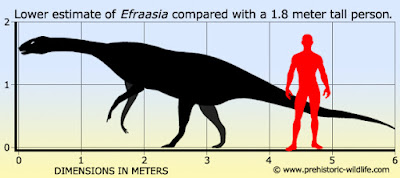This study will likely take a couple months, but at the end of each month I'll include links to what we've already covered. Here are the studies we knocked out this month:
Sunday, February 28, 2021
family devotions: Revelation [I]
Tuesday, February 23, 2021
Monday, February 22, 2021
Dino of the Week: Eoraptor
Type Species: Eoraptor lunensis
Classification: Dinosauria - Saurischia - Theropoda
Time Period: Late Triassic
Location: Argentina
Diet: Omnivore
Classification: Dinosauria - Saurischia - Theropoda
Time Period: Late Triassic
Location: Argentina
Diet: Omnivore
Eoraptor lived in what is modern-day Argentina. It had a slender body that reached about three feet in length and weighed around twenty pounds. Its skull was lightly built and similar to those of the later coelophysoids. Like all dinosaurs it had a digitigrade stance, walking upright on its toes, and it stood upright on its hind legs. All of its long bones had hollow shafts and hollow central vertebrae. It had five digits on each ‘hand,’ the three longest of which ended in large claws presumably used to handle prey. It had heterodont teeth (meaning it had multiple types of teeth), so it’s speculated that it was omnivorous. It had serrated, recurved teeth in its upper jaws (like those of later theropods) and leaf-shaped teeth in the lower jaw (like those of prosauropods). It was a fast runner and could use its claws and teeth to tear prey apart. Unlike later theropods, it lacked a sliding joint at the articulation of the lower jaw that would enable it to hold large prey. Its remains have been found in what was once a volcanically-active floodplain covered by forests with a warm and humid climate subject to monsoons. It lived among ferns, horsetails, and giant conifers of the highland forests that stretched along the banks of rivers. It was likely preyed upon by another (and much larger) early theropod, Herrerasaurus. Eoraptor would’ve shared its environment with Carnian therapsids, rauisuchians, and archosaurs. Dinosaurs, of which Eoraptor was a part, represent only six percent of the fauna found in Argentina. It certainly wasn’t the dominant creature.
Monday, February 15, 2021
Dino of the Week: Euskelosaurus
Type Species: Euskelosaurus browni
Classification: Dinosauria - Saurischia - Sauropodomorpha - Prosauropoda
Time Period: Late Triassic
Location: Africa
Diet: Herbivore
This Upper Triassic to Lower Jurassic prosauropod was the first dinosaur to be discovered in Africa, and the number of specimens found in South African sandstones imply it had been a staple of the area’s ecosystem. Euskelosaurus foreshadowed the giant sauropods of the Jurassic, with adults reaching up to forty feet long head-to-tail (that estimate may change depending on the head; though scientists have a good idea of what it looked like, a skull has yet to be found). Its name means “good-limbed lizard,” and it strikes a chord of irony: the shaft of its thigh bone was twisted, which may have rendered it bow-legged! Because dinosaurs positioned their legs underneath their bodies, this anatomical feature is a bit of a mystery. Some have proposed that Euskelosaurus’s earliest versions had an erect posture, but as its body grew larger, vastly exceeding the size of its proto-dinosaurian ancestors, its femur twisted in an evolutionary attempt to handle the added weight. This evolutionary sideshow would’ve been inefficient compared to keeping an erect stance, and perhaps this is seen in the fact that Euskelosaurus doesn’t seem to have made it past the Lower Jurassic.
Monday, February 08, 2021
Dino of the Week: Daemonosaurus
Type Species: Daemonosaurus chauliodus
Classification: Dinosauria - Saurischia - Theropoda
Time Period: Late Triassic
Location: North America
Diet: Carnivore
Classification: Dinosauria - Saurischia - Theropoda
Time Period: Late Triassic
Location: North America
Diet: Carnivore
Daemonosaurus lived during the Late Triassic of Mexico. It’s considered a basal theropod that lies outside the clade Neotheropoda; in other words, it was closely related to the family line that would survive into the Jurassic and diversify into the ceratosaurs and tetanurans, but it was part of the ‘old breed’ that wouldn’t make it past the Triassic-Jurassic extinction event. Daemonosaurus had a short skull and long protruding teeth, making it vividly different than the slender-skulled theropods that dominated the Late Triassic. It may have reached up to five feet in length, but many paleontologists believe it was shorter than this. It lived in the area of Ghost Ranch among such Late Triassic citizens as the rhynchosaurs, archosaurs, pseudosuchians, and primitive crocodilians – not to mention Coelophysis.
Monday, February 01, 2021
Dino of the Week: Efraasia
Type Species: Efraasia minor
Classification: Dinosauria - Saurischia - Sauropodomorpha - Prosauropoda
Time Period: Late Triassic
Location: Germany
Diet: Herbivore
Efraasia was a prosauropod herbivore that lived during the middle Norian stage of the Late Triassic (around 210 mya). Several specimens have been discovered in Germany, and though these were attributed to various species of Efraasia, recently they were combined into one species: Efraasia minor. Like Mussaurus, Efraasia was considered to be a ‘small fry’ that reached only about seven to ten feet in length. Upon further examination, however, it became apparent that the fossils belonged to a juvenile; adult length has been estimated around twenty-one feet. Efraasia was lightly-built with gracile hands and feet. It had long fingers and mobile thumbs, with which it could grasp food, and the anatomy of its wrists may have enabled it to walk on all fours. Its skull was small, pointed, and triangular. Its neck was only moderately elongated and thin. A cluster of gastroliths (stomach stones) was found near one specimen.
Subscribe to:
Comments (Atom)
books read: 2024
this year I read 60 books, meeting my goal of reading less than last year! ~ Nonfiction ~ HISTORY The Cultural Atlas of Ancient Egypt (J...

-
Paul vs. the Judaizers When we read St. Paul’s letter to the Galatians, we are reading not a theological treatise but rather a snapshot of ...
-
"I stand between the saint and the sinner, chasing after holiness, close enough to grasp, but still it's just beyond my reach. Who ...
-
Summer has finally came to an end, and hopefully so have my sporadic updates. Working at the Girl Scout Camp ended on August 1 st , and rig...


















